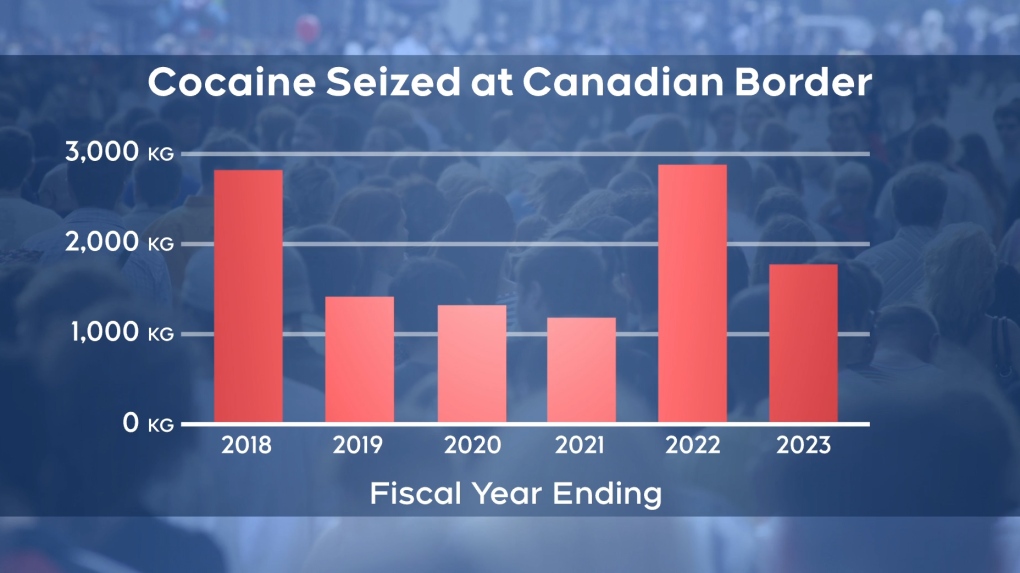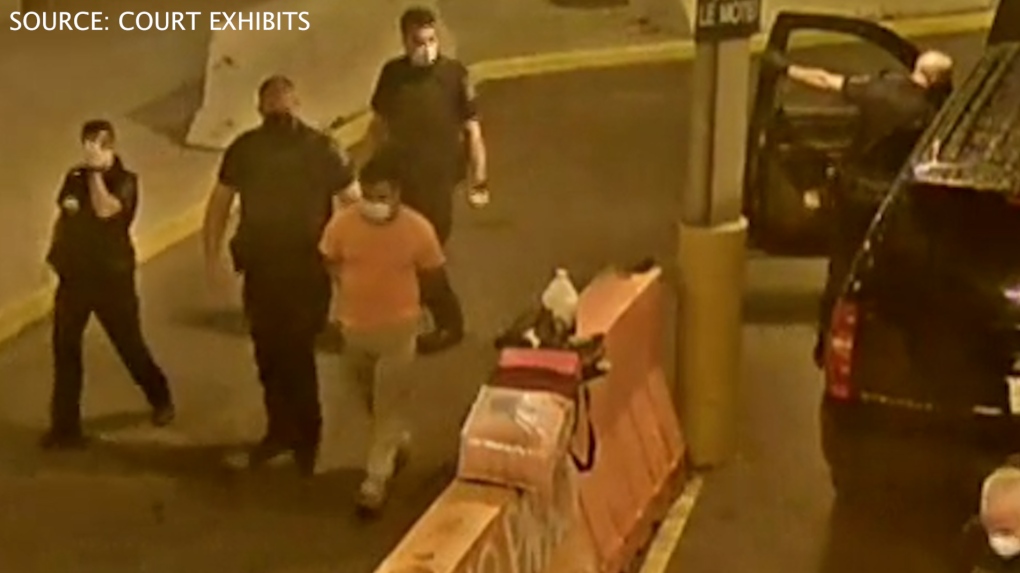Cocaine seizures at Canada's borders spike as pandemic wanes
Cocaine seizures at Canada’s borders rose sharply when restrictions loosened, according to new figures released by the Canadian Border Services Agency, with experts saying it’s a sign that drug traffickers are getting back to business as the pandemic wanes.
Facing a downturn in regular trade, drug trafficking networks turned to couriers which were more likely to be caught at ports of entry, Mount Royal University’s Kelly Sundberg told CTV News Toronto in an interview.
“It was much more difficult for drug dealers to smuggle during [the pandemic],” Sundberg said. “They changed their operation to couriers. It makes sense we’re seeing more seizures at airports and cargo with couriers.”
In the fiscal year ending in 2018, CBSA agents seized 2,860 kg of cocaine, including coca leaves, coca paste, crack cocaine, and cocaine residue, according to figures provided by the agency.
By the fiscal year ending in 2021 — the year that corresponded to the onset of the pandemic — that had nosedived to 1,214 kg of cocaine.
 Source: CBSA
Source: CBSA
The next year, propelled in part by one 1.5-ton seizure in the port of St. John, CBSA cocaine seizures rose to 2,875 kg.
And the following year stayed high, at 1,812 kg — about 50 per cent more than pandemic lows.
A Windsor, Ont. judge weighed in on a CBSA seizure in a decision released this month, finding Federico Jimenez-Martinez guilty of possession for the 18 bricks of cocaine found in his vehicle’s spare tire, worth as much as $2 million.
He admitted having the cocaine in August 2021, but said he had only intended to drive from Arizona to Michigan, U.S., and went over the Ambassador Bridge into Ontario by accident, court documents show.
Prosecutors admitted they couldn’t prove he intended to cross the border, and withdrew an additional trafficking charge.
Jimenez-Martinez claimed that he was under duress, facing threats by cartel members in Mexico if he didn’t deliver.
Justice K.W. Munroe found his brother did receive threats — but it was much more likely that was the cartel looking to enforce a drug debt created when those bricks didn’t arrive at their destination.
 A still image from CBSA surveillance video obtained from Ontario Superior Court shows Federico Jimenez-Martinez being led away as his vehicle is searched by border guards.
A still image from CBSA surveillance video obtained from Ontario Superior Court shows Federico Jimenez-Martinez being led away as his vehicle is searched by border guards.
As seized amounts rise, it’s likely that the amount of cocaine being smuggled in undetected is also increasing, Sundberg said, pointing to figures that show Canadians’ per capita use of cocaine is quite high, and the country has negligible cocaine production.
“Last year, New Zealand seized more cocaine than Canada. A tiny little island in the Pacific. So 3,000 kg sounds like a lot, but it’s to me an indicator that we really need to do a lot more with respect to border security, and we’re not,” he said.
CTVNews.ca Top Stories

India's foreign minister reacts to murder charges, claims Canada welcomes criminals
India's Foreign Affairs Minister accused Canada of welcoming criminals from his country in response to the RCMP's recent arrests in a homicide that has roiled tensions between the two countries.
15-year-old boy stabbed in Ottawa on Thursday dies
A 15-year old boy who was critically injured after a stabbing in Nepean on Thursday has died of his injuries, Ottawa's English public school board said Sunday.
Dash cam catches moment suspected drunk driver hits parked car, sends it careening into North Shore flower shop
Police say it’s fortunate no one was injured or killed in a collision at North Vancouver’s Park and Tilford shopping centre Saturday evening that sent one vehicle careening into a flower shop and another into a set of concrete barriers outside a Winners store.
Actor Bernard Hill, of 'Titanic' and 'Lord of the Rings,' has died at 79
Actor Bernard Hill, who delivered a rousing cry before leading his people into battle in 'The Lord of the Rings: The Return of the King' and went down with the ship as the captain in 'Titanic,' has died.
'A tiny city:' Pro-Palestinian campus protesters organize for another week
Pro-Palestinian activists have set up tents at universities in Toronto, Ottawa, Vancouver and Montreal, following a wave of similar protests at campuses in the United States linked to the Israel-Hamas war.
Lawsuit against Meta asks if Facebook users have right to control their feeds using external tools
Do social media users have the right to control what they see — or don't see — on their feeds?
A Holocaust survivor will mark that history differently after the horrors of Oct. 7
This year's Holocaust Remembrance Day, which begins on Sunday evening in Israel, carries a heavier weight than usual for many Jews around the world.
Princess Anne lays wreath at Battle of Atlantic ceremony; honours late Queen
Princess Anne saluted Canadian veterans and current forces members and honoured her late mother during separate ceremonies Sunday in Victoria as she wrapped up a three-day British Columbia West Coast royal visit.
El Nino weakening doesn't mean cooler temperatures this summer, forecasters say
As Canadians brace themselves for summer temperatures, forecasters say a weakening El Nino cycle doesn’t mean relief from the heat.

































